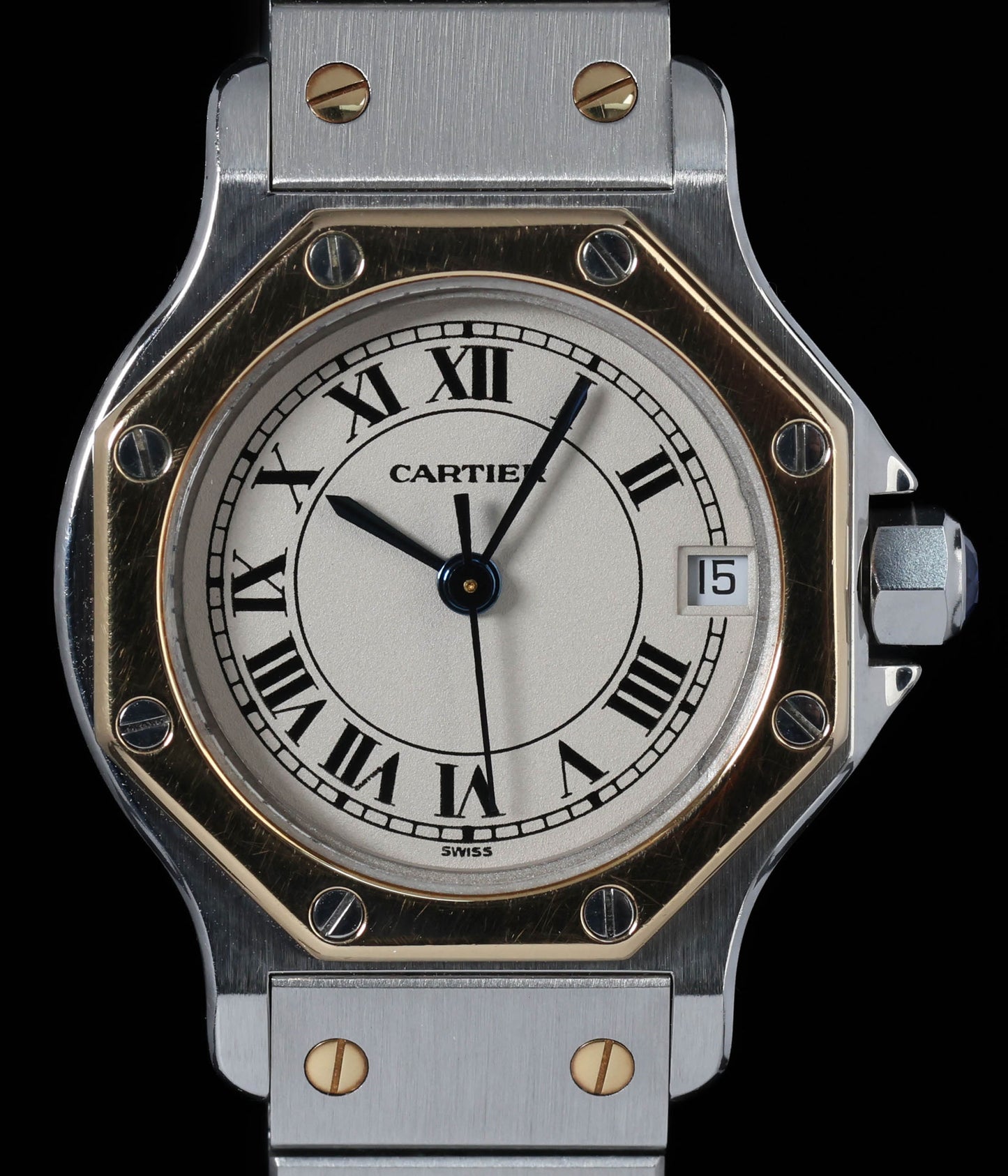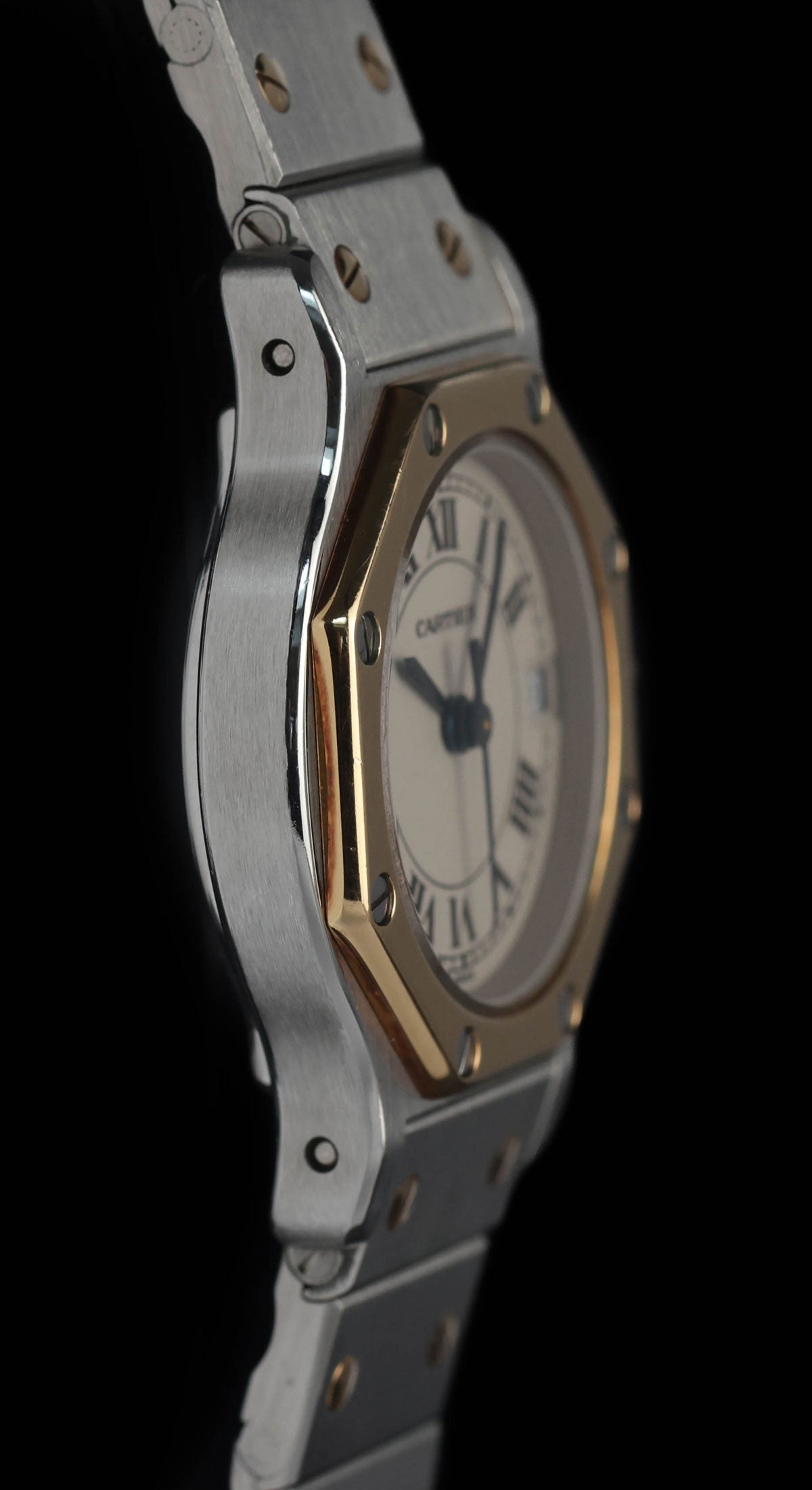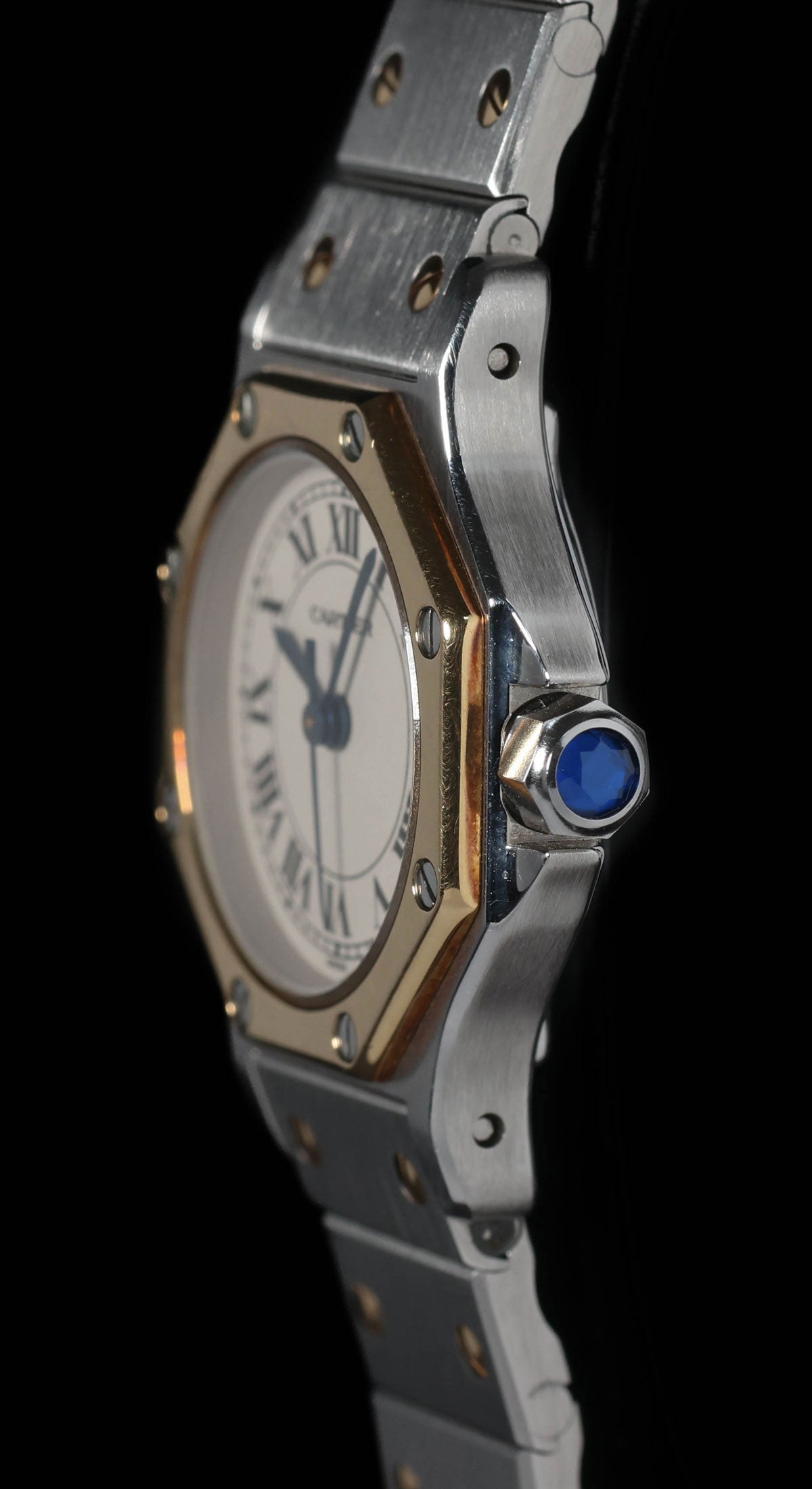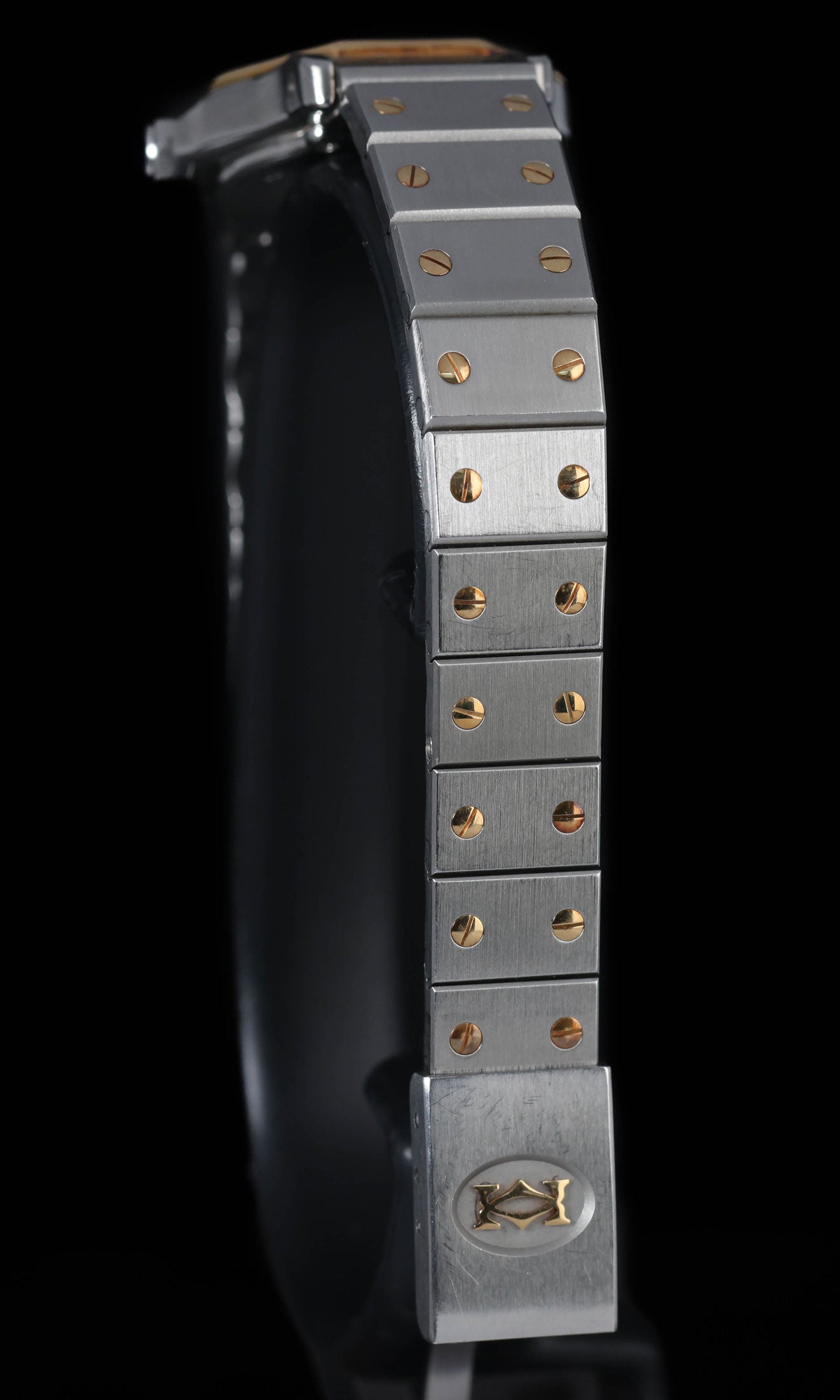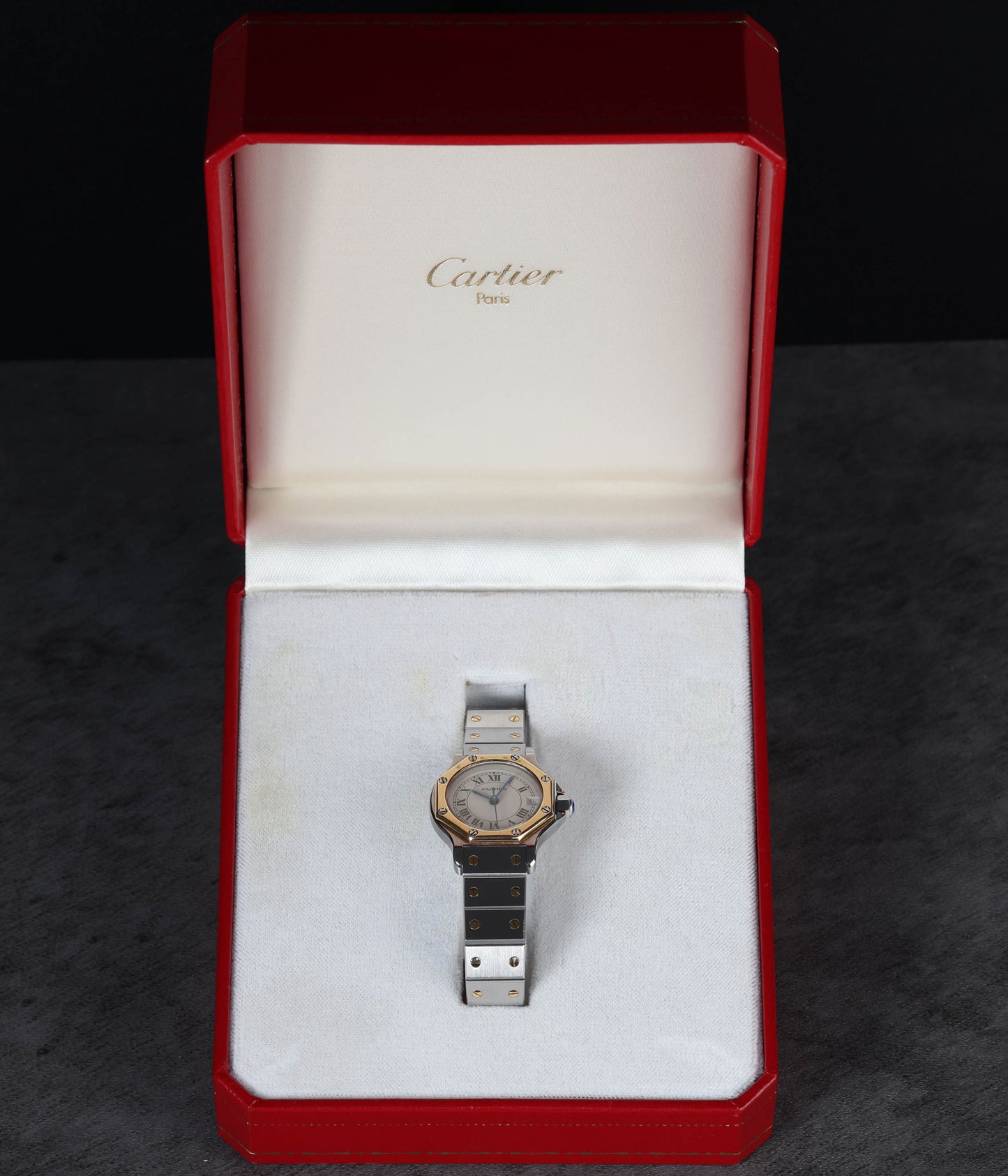Crown Vintage
Cartier Santos Octagon Two Tone Ref. 187903 Circa 1990
Cartier Santos Octagon Two Tone Ref. 187903 Circa 1990
Couldn't load pickup availability
Cartier Santos Octagon
Case shows light hairlines typical of careful, age-appropriate wear yet retains crisp edges and original finishing, presenting well on the wrist. Bracelet likewise bears minor surface marks but remains tight and fully functional, with screws and links in good order. Dial and hands are excellent—clean printing, strong colour, and no signs of oxidation or lume loss—completing a well-kept vintage example.
Share
Why we love this watch
Why we love this watch
Cartier’s eight-sided Santos
When Cartier gave its square-cased Santos an octagonal makeover in the late 1980s, the maison quietly produced one of the most distinctive interpretations of the long-running aviator’s watch. The two-tone steel-and-yellow-gold Santos Octagon delivered all the familiar hallmarks—Roman numerals, exposed screws, blue cabochon crown—but reframed them inside a faceted case that felt equal parts Art Deco and late-20th-century chic. It arrived at a moment when slim quartz movements, integrated bracelets and mixed metals defined everyday luxury, and it still captures that mood today.
From Alberto Santos-Dumont to eight sides
The original 1904 Santos solved a practical problem for Brazilian aviator Alberto Santos-Dumont: read the time without fumbling for a pocket-watch mid-flight. That square design, produced commercially from 1911, is often cited as the first purpose-built men’s wrist-watch. Decades later Cartier broadened its audience by offering a steel model with gold screws and bezel in 1978—a strategic move conceived by then-CEO Alain-Dominique Perrin to meet demand for sportier yet still refined watches.
The Octagon picked up that formula and added a geometry that echoed early Cartier jewellery: sharp angles, crisp bevels and a sense of symmetry that contrasted with the cushion and tonneau cases dominating 1980s watch design. Retaining the Santos name kept the lineage clear while signalling that this was not merely a cosmetic variant but a fully integrated member of the family.
Why eight beats four
Cartier never explained publicly why it moved from four sides to eight, yet the answer is plain when you handle the watch. The extra facets break reflections into muted flashes rather than a single broad glare, softening the overall look. They also allowed the bezel screws—eight of them, matching the case geometry—to sit further from the dial, making room for a narrower chapter ring and giving the Roman numerals more breathing space. The resulting visual lightness offsets the use of yellow gold, preventing the bezel from overwhelming the modest case diameter.
Two-tone and the late-1980s aesthetic
Mixed metal was everywhere by the end of the 1980s, from jewellery to architectural hardware. Cartier’s take balanced warm 18-carat gold on the bezel and bracelet screws against cool stainless-steel surfaces. The contrast was deliberate: gold announced prestige, steel hinted at robustness, and together they made the watch versatile enough for a linen suit at lunch and a navy blazer after dark. Unlike solid-gold models, the two-tone Santos felt attainable without sacrificing the Cartier mystique—an important point in the brand’s push to widen its customer base.
Case, bezel and crystal
Most examples measure a svelte 25–26 mm across the bezel, with the case extending barely 7 mm off the wrist—dimensions made possible by a thin quartz calibre. Stainless-steel case flanks are satin-brushed, while bevels and bezel receive a high polish that accentuates each facet. The bezel itself is solid yellow gold, secured by eight flat-slot screws whose alignment mirrors the case edges. A scratch-resistant sapphire crystal protects the dial and contributes to a published water-resistance of 30 metres, sufficient for rain and hand-washing but not designed for prolonged swimming.
On the right side sits Cartier’s signature octagonal crown set with a blue synthetic spinel cabochon. The crown is push-pull rather than screw-down—again a nod to elegance over outright sport capability—yet it seals effectively when new gaskets are fitted at service.
Bracelet architecture
Cartier integrated the bracelet so closely that the watch head appears to flow straight into each link. Central gold screws pierce every stainless-steel link, echoing the bezel hardware and giving the bracelet a distinctive rhythm of alternating metals. Flexibility comes from short links and concealed pins, so even the smaller 25 mm case drapes naturally on wrists of varied sizes. A folding clasp keeps the overall profile slim; its cover is signed Cartier in the serif script used on dial signatures, a quiet piece of brand consistency.
Stretch is rare if the bracelet has been properly maintained, and replacement links remain available through Cartier service centres—an advantage over many discontinued integrated designs from the period.
Inside: high-grade Swiss quartz
Cartier housed the Octagon in a jewelled, Swiss-made quartz movement branded Cartier calibre 81 (later versions used 87 family upgrades). These calibres were based on reliable ETA architecture, customised with Cartier plates and finishing. They offered hacking seconds, quick-set date at three o’clock and a battery life of around three years. Accuracy sat well within ±20 seconds per month—a standard quartz figure but a leap forward from most mechanical rivals of the day.
For owners today, the movement’s modular design means routine service is straightforward: gasket replacement, battery swap and timing check. Parts supply is healthy thanks to ETA’s continued production of many base components. The only caution is to replace batteries promptly to avoid leakage that can corrode plate surfaces.
On the wrist
At first glance the watch appears petite by contemporary standards, yet the octagonal bezel and warm gold accents create greater visual presence than the diameter suggests. The white (often called ivory) dial plays a large role: broad Roman numerals, a railway minutes track and blued-steel sword hands command attention. Sunlight catches the polished bezel and bracelet screws, while the brushed steel tones down the overall shine, preventing the watch from crossing into ostentation.
Weight distribution is even, around 70 grams on the bracelet, so the watch sits flat without sliding—a point many modern wearers appreciate when switching from heavier sports pieces. Low overall height helps the Octagon slip under a cuff, making it an ideal travel companion or daily-wear piece for those who move between formal and casual settings.
Strategic place within the Santos family
By carving eight new edges into a stalwart design, Cartier demonstrated that evolution need not mean abandoning heritage. The Octagon kept key Santos traits—visible screws, industrial chic, Roman typography—while offering a fresh silhouette that could coexist with the square original. It also underlined Cartier’s strategy of modularising its line-up: one design language, multiple case shapes, a choice of quartz or automatic movements, steel, gold or both.
Because the octagonal variant never achieved the production volumes of the classic square version, it retains an appealing scarcity without being hard to source or service. Prices remain accessible relative to Cartier’s current catalogue, partly because the market still focuses on larger sports models and mechanical movements.
Culture, fashion and quiet luxury
Two-tone jewellery has cycled in and out of fashion; today it is back under the banner of “quiet luxury”, prized for subtle mixing rather than overt branding. The Octagon anticipates that trend: there is no model name on the dial, just Cartier at 12 o’clock and Swiss Made at six. The watch communicates status through design cues rather than logos—something modern buyers attuned to understatement increasingly favour.
Pop-culture sightings from Wall Street boardrooms to European art-house films of the early 1990s show how the watch fitted the era’s sleek tailoring and restrained colour palettes. Its current resurgence owes much to that cross-gender, cross-occasion versatility: at 25–26 mm it wears comfortably on a male or female wrist, and its mixed metals pair with silver or gold jewellery.
Final thoughts
The octagonal Santos distils Cartier’s design vocabulary into a watch that feels purpose-built for everyday sophistication: slim, precise, wearable with anything and instantly recognisable without shouting. Its blend of steel functionality and gold warmth reflects both the pragmatism and optimism of the late 1980s, while the quartz heart delivers to-the-second dependability that mechanical rivals still chase. For anyone wanting a slice of Cartier heritage that stands apart from the square crowds yet stays true to the brand’s aesthetic roots, this eight-sided Santos remains a compelling, and still somewhat under-the-radar, choice.
Case & Bracelet
Case & Bracelet
Case in good vintage condition with light hairlines visible around case but presents itself in overall good condition. Bracelet shows light hairlines but overall in good condition.
Dial & Hands
Dial & Hands
Dial and hands are in excellent condition.
Warranty & Condition
Warranty & Condition
Crown Vintage Watches provides a minimum 3-month mechanical warranty on pre-owned watches, from the date of purchase.
The warranty covers mechanical defects only.
The warranty does not cover damages such as scratches, finish, crystals, glass, straps (leather, fabric or rubber damage due to wear and tear), damage resulting from wear under conditions exceeding the watch manufacturer’s water resistance limitations, and damage due to physical and or accidental abuse.
Please note, water resistance is neither tested nor guaranteed.
Shipping and insurance costs for warranty returns to us must be covered by the customer. Returns must be shipped via traceable courier. Return shipment must be pre-paid and fully insured. Collect shipping will be refused. In case of loss or damages, the customer is liable.
Our Pledge
At Crown Vintage Watches, we stand by the authenticity of every product we sell. For added peace of mind, customers are welcome to have items independently authenticated at their own expense.
Condition
Due to the nature of vintage timepieces, all watches are sold as is. We will accurately describe the current condition and working order of all watches we sell to the best of our ability.
Shipping & Refund
Shipping & Refund
